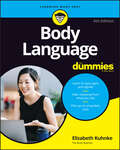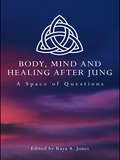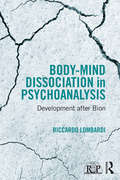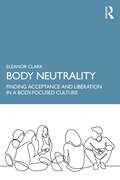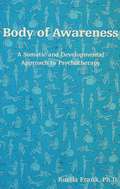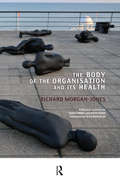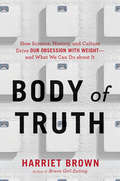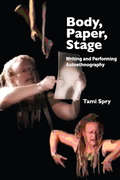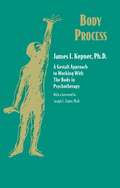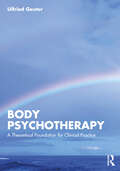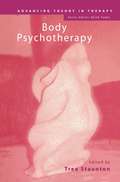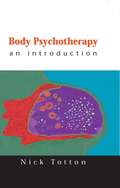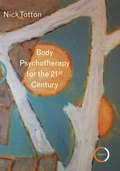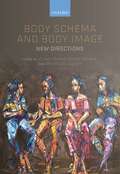- Table View
- List View
Body Language For Dummies
by Elizabeth KuhnkeAre your words and your body telling the same story? Discover the impact that nonverbal behavior has on communication Much of a message’s meaning comes through what’s not being said. To master the art of clear communication, you need to be able to read others’ body language and remain mindful of the messages your own gestures, movements, and facial expressions are sending. Body Language For Dummies shows you how to interpret nonverbal cues at work and in your personal life. With the help of this easy-to-follow Dummies guide, you can navigate the gap between words and meaning—even in multicultural settings. Plus, this updated edition goes virtual, with new insights demonstrating the significance of facial expressions and body language in online vs. in-person meetings. Gain insight into other people’s thoughts, feelings, and intentions Develop an awareness of how your body language influences others’ opinions Make the camera your friend during virtual meetings Learn tips and tricks to uncover people’s real attitudes and motivationsIf you want to better understand others and improve your own communication skills (and who doesn’t?), this is the Dummies book for you.
Body Language For Dummies
by Elizabeth KuhnkeAre your words and your body telling the same story? Discover the impact that nonverbal behavior has on communication Much of a message’s meaning comes through what’s not being said. To master the art of clear communication, you need to be able to read others’ body language and remain mindful of the messages your own gestures, movements, and facial expressions are sending. Body Language For Dummies shows you how to interpret nonverbal cues at work and in your personal life. With the help of this easy-to-follow Dummies guide, you can navigate the gap between words and meaning—even in multicultural settings. Plus, this updated edition goes virtual, with new insights demonstrating the significance of facial expressions and body language in online vs. in-person meetings. Gain insight into other people’s thoughts, feelings, and intentions Develop an awareness of how your body language influences others’ opinions Make the camera your friend during virtual meetings Learn tips and tricks to uncover people’s real attitudes and motivationsIf you want to better understand others and improve your own communication skills (and who doesn’t?), this is the Dummies book for you.
Body, Mind and Healing After Jung: A Space of Questions
by Raya A. JonesIt is difficult to point to an aspect of Jungian psychology that does not touch on mind, body and healing in some way. In this book Raya Jones draws on the triad of body, mind and healing and (re)presents it as a domain of ongoing uncertainty within which Jung’s answers stir up further questions. Contributors from both clinical and scholarly backgrounds offer a variety of cultural and historical perspectives. Areas of discussion include: the psychosomatic nature of patients’ problems transference and counter-transference therapeutic techniques centred on movement or touch. Striking a delicate balance between theory-centred and practice-oriented approaches Body, Mind and Healing After Jung is essential reading for all Jungians.
Body, Mind and Healing After Jung: A Space of Questions
by Raya A. JonesIt is difficult to point to an aspect of Jungian psychology that does not touch on mind, body and healing in some way. In this book Raya Jones draws on the triad of body, mind and healing and (re)presents it as a domain of ongoing uncertainty within which Jung’s answers stir up further questions. Contributors from both clinical and scholarly backgrounds offer a variety of cultural and historical perspectives. Areas of discussion include: the psychosomatic nature of patients’ problems transference and counter-transference therapeutic techniques centred on movement or touch. Striking a delicate balance between theory-centred and practice-oriented approaches Body, Mind and Healing After Jung is essential reading for all Jungians.
Body-Mind Dissociation in Psychoanalysis: Development after Bion (Relational Perspectives Book Series)
by Riccardo LombardiThe conflict and dissociation between the Body and the Mind have determinant implications in the context of our current clinical practice, and are an important source of internal and relational disturbances. Body-Mind Dissociation in Psychoanalysis proposes the concept as a new hypothesis, different from traumatic dissociation or states of splitting. This approach opens the door to a clinical confrontation with extreme forms of mental disturbance, such as psychosis or borderline disorders, and strengthens the relational power of the analytic encounter, through a focus on the internal sensory/emotional axis in both analyst and analysand. The book details this importance of the analyst’s intrasubjective relationship with the analysand in constructing new developmental horizons, starting from the body-mind exchange of the two participants. Body-Mind Dissociation in Psychoanalysis will be of use to students, beginners in psychotherapy, mental health practitioners and seasoned psychoanalysts.
Body-Mind Dissociation in Psychoanalysis: Development after Bion (Relational Perspectives Book Series)
by Riccardo LombardiThe conflict and dissociation between the Body and the Mind have determinant implications in the context of our current clinical practice, and are an important source of internal and relational disturbances. Body-Mind Dissociation in Psychoanalysis proposes the concept as a new hypothesis, different from traumatic dissociation or states of splitting. This approach opens the door to a clinical confrontation with extreme forms of mental disturbance, such as psychosis or borderline disorders, and strengthens the relational power of the analytic encounter, through a focus on the internal sensory/emotional axis in both analyst and analysand. The book details this importance of the analyst’s intrasubjective relationship with the analysand in constructing new developmental horizons, starting from the body-mind exchange of the two participants. Body-Mind Dissociation in Psychoanalysis will be of use to students, beginners in psychotherapy, mental health practitioners and seasoned psychoanalysts.
Body Neutrality: Finding Acceptance and Liberation in a Body-Focused Culture
by Eleanor ClarkThis practical, accessible book teaches readers how to practice healthy body image habits and let go of an emphasis on body image through research, activities, and personal stories. Body neutrality is a body image approach focused on finding acceptance and liberation from the body-focused culture in which we live. Body neutrality is a shift toward seeing our bodies as a vessel of who we are rather than as who we are. This guide is organized into thirteen chapters, each outlining a different concept of body neutrality ranging from comparison and identity to mindfulness and gratitude, inviting participation from the reader through end-of-chapter activities. For anyone aiming to release the enslaving emphasis placed on appearance in a world where body obsession has become inappropriately “normal,” this book will provide insight and practical guidance toward freedom. Body Neutrality is for anyone struggling with self-esteem and body image issues who aims for acceptance and liberation.
Body Neutrality: Finding Acceptance and Liberation in a Body-Focused Culture
by Eleanor ClarkThis practical, accessible book teaches readers how to practice healthy body image habits and let go of an emphasis on body image through research, activities, and personal stories. Body neutrality is a body image approach focused on finding acceptance and liberation from the body-focused culture in which we live. Body neutrality is a shift toward seeing our bodies as a vessel of who we are rather than as who we are. This guide is organized into thirteen chapters, each outlining a different concept of body neutrality ranging from comparison and identity to mindfulness and gratitude, inviting participation from the reader through end-of-chapter activities. For anyone aiming to release the enslaving emphasis placed on appearance in a world where body obsession has become inappropriately “normal,” this book will provide insight and practical guidance toward freedom. Body Neutrality is for anyone struggling with self-esteem and body image issues who aims for acceptance and liberation.
Body of Awareness: A Somatic and Developmental Approach to Psychotherapy
by Ruella FrankMerging scientific theory with a practical, clinical approach, Body of Awareness explores the formation of infant movement experience and its manifest influence upon the later adult. Most significantly, it shows how the organizing principles in early development are functionally equivalent to those of the adult. It demonstrates how movement plays a critical role in a developing self-awareness for the infant and in maintaining a healthy self throughout life. In addition, a variety of case studies illustrates how infant developmental movement patterns are part of the moment-to-moment processes of the adult client and how to bring these patterns to awareness within therapy. Body of Awareness is intended to help therapists, new or advanced, to enhance their skills of attunement. They can do this by heightening their observations of subtle movement patterns as they emerge within the client/therapist relationship, and by respective their own developing feelings within session as essential information to the therapy process. And as developmental patterns are central to psychological functioning, a background study of movement provides the therapist with critical insight into the unfolding psychodynamic field.
Body of Awareness: A Somatic and Developmental Approach to Psychotherapy
by Ruella FrankMerging scientific theory with a practical, clinical approach, Body of Awareness explores the formation of infant movement experience and its manifest influence upon the later adult. Most significantly, it shows how the organizing principles in early development are functionally equivalent to those of the adult. It demonstrates how movement plays a critical role in a developing self-awareness for the infant and in maintaining a healthy self throughout life. In addition, a variety of case studies illustrates how infant developmental movement patterns are part of the moment-to-moment processes of the adult client and how to bring these patterns to awareness within therapy. Body of Awareness is intended to help therapists, new or advanced, to enhance their skills of attunement. They can do this by heightening their observations of subtle movement patterns as they emerge within the client/therapist relationship, and by respective their own developing feelings within session as essential information to the therapy process. And as developmental patterns are central to psychological functioning, a background study of movement provides the therapist with critical insight into the unfolding psychodynamic field.
The Body of the Organisation and its Health
by Richard Morgan-JonesUsing the frameworks of psychoanalysis, group relations, systemic organisational observation, consulting and research, this book explores the relationship between the health of the work force and the health of organisations. It seeks to do this through an exploration of experience that has three dimensions linked in a single matrix: The bodily, the emotional and the social. This exploration is inspired by Bion's original idea of the protomental matrix from which the group dynamics of basic assumption mentality are derived, leading to his initial ideas about group diseases and their cures.
The Body of the Organisation and its Health
by Richard Morgan-JonesUsing the frameworks of psychoanalysis, group relations, systemic organisational observation, consulting and research, this book explores the relationship between the health of the work force and the health of organisations. It seeks to do this through an exploration of experience that has three dimensions linked in a single matrix: The bodily, the emotional and the social. This exploration is inspired by Bion's original idea of the protomental matrix from which the group dynamics of basic assumption mentality are derived, leading to his initial ideas about group diseases and their cures.
Body of Truth: How Science, History, and Culture Drive Our Obsession with Weight--and What We Can Do about It
by Harriet BrownOver the past twenty-five years, our quest for thinness has morphed into a relentless obsession with weight and body image. In our culture, "fat" has become a four-letter word. Or, as Lance Armstrong said to the wife of a former teammate, "I called you crazy. I called you a bitch. But I never called you fat." How did we get to this place where the worst insult you can hurl at someone is "fat"? Where women and girls (and increasingly men and boys) will diet, purge, overeat, undereat, and berate themselves and others, all in the name of being thin?As a science journalist, Harriet Brown has explored this collective longing and fixation from an objective perspective; as a mother, wife, and woman with "weight issues," she has struggled to understand it on a personal level. Now, in Body of Truth, Brown systematically unpacks what's been offered as "truth" about weight and health.Starting with the four biggest lies, Brown shows how research has been manipulated; how the medical profession is complicit in keeping us in the dark; how big pharma and big, empty promises equal big, big dollars; how much of what we know (or think we know) about health and weight is wrong. And how all of those affect all of us every day, whether we know it or not.The quest for health and wellness has never been more urgent, yet most of us continue to buy into fad diets and unattainable body ideals, unaware of the damage we're doing to ourselves. Through interviews, research, and her own experience, Brown not only gives us the real story on weight, health, and beauty, but also offers concrete suggestions for how each of us can sort through the lies and misconceptions and make peace with and for ourselves.
Body, Paper, Stage: Writing and Performing Autoethnography (Qualitative Inquiry and Social Justice)
by Tami SpryTami Spry provides a methodological introduction to the budding field of performative autoethnography. She intertwines three necessary elements comprising the process. First one must understand the body – navigating concepts of self, culture, language, class, race, gender, and physicality. The second task is to put that body on the page, assigning words for that body’s sociocultural experiences. Finally, this merger of body and paper is lifted up to the stage, crafting a persona as a method of personal inquiry. These three stages are simultaneous and interdependent, and only in cultivating all three does performance autoethnography begin to take shape. Replete with examples and exercises, this is an important introductory work for autoethnographers and performance artists alike.
Body, Paper, Stage: Writing and Performing Autoethnography (Qualitative Inquiry and Social Justice #2)
by Tami SpryTami Spry provides a methodological introduction to the budding field of performative autoethnography. She intertwines three necessary elements comprising the process. First one must understand the body – navigating concepts of self, culture, language, class, race, gender, and physicality. The second task is to put that body on the page, assigning words for that body’s sociocultural experiences. Finally, this merger of body and paper is lifted up to the stage, crafting a persona as a method of personal inquiry. These three stages are simultaneous and interdependent, and only in cultivating all three does performance autoethnography begin to take shape. Replete with examples and exercises, this is an important introductory work for autoethnographers and performance artists alike.
Body Process: A Gestalt Approach to Working with the Body in Psychotherapy
by James I. KepnerTraditional psychotherapy approaches, focusing on working with and correcting mental events and conditions, have placed little importance on the fundamentally physical nature of the person. Yet many of the problems people bring to therapy are linked with or manifested in the body--such as obesity, psychosomatic distress, chronic tension, and sexual problems. This book provides a therapeutic approach that addresses both the physical and mental nature of clients. In this book, James Kepner shows that a client's posture, movements, and bodily experiences are indeed relevant to therapy, and he offers an insightful framework for incorporating these aspects into a therapeutic framework. This comprehensive treatment explains how body work can be integrated with the aims, methods, and philosophy of psychotherapy, offering a framework within which practitioners of different theoretical approaches can better appreciate body processes in the context of the whole person, rather than as isolated events. This book, including an updated introduction by the author, explores the range of body work in psychotherapy, from the development of body awareness to intensive work with physical structure and expression. And it demonstrates how this approach can be particularly effective with a range of clients, including survivors of sexual abuse, recovering drug addicts or alcoholics, or those suffering from chronic illness.
Body Process: A Gestalt Approach to Working with the Body in Psychotherapy
by James I. KepnerTraditional psychotherapy approaches, focusing on working with and correcting mental events and conditions, have placed little importance on the fundamentally physical nature of the person. Yet many of the problems people bring to therapy are linked with or manifested in the body--such as obesity, psychosomatic distress, chronic tension, and sexual problems. This book provides a therapeutic approach that addresses both the physical and mental nature of clients. In this book, James Kepner shows that a client's posture, movements, and bodily experiences are indeed relevant to therapy, and he offers an insightful framework for incorporating these aspects into a therapeutic framework. This comprehensive treatment explains how body work can be integrated with the aims, methods, and philosophy of psychotherapy, offering a framework within which practitioners of different theoretical approaches can better appreciate body processes in the context of the whole person, rather than as isolated events. This book, including an updated introduction by the author, explores the range of body work in psychotherapy, from the development of body awareness to intensive work with physical structure and expression. And it demonstrates how this approach can be particularly effective with a range of clients, including survivors of sexual abuse, recovering drug addicts or alcoholics, or those suffering from chronic illness.
Body Psychotherapy: A Theoretical Foundation for Clinical Practice
by Ulfried GeuterThis book introduces body psychotherapy as one of the essential approaches in psychotherapy, reflecting the increasing integration of the body into clinical mental health practice. The book offers an entirely new view on body psychotherapy based upon advanced research on embodiment, memory, emotion regulation, developmental psychology and body communication and an experiential and relational understanding of psychotherapy. Accordingly, the author grounds the theory of body psychotherapy on the theoretical approach of enactivism, which regards experience as arising from meaningful living interaction with others and their environment. The book, fortified with clinical examples, shows the distinctiveness of body psychotherapy as compared with a traditional talking therapy approach. It also convincingly demonstrates that each form of psychotherapy should consider body experiences. This text will be a comprehensive foundation for psychotherapists of every orientation, scholars of the humanities and students and especially those wishing to integrate embodied experience into their understanding of their patients.
Body Psychotherapy: A Theoretical Foundation for Clinical Practice
by Ulfried GeuterThis book introduces body psychotherapy as one of the essential approaches in psychotherapy, reflecting the increasing integration of the body into clinical mental health practice. The book offers an entirely new view on body psychotherapy based upon advanced research on embodiment, memory, emotion regulation, developmental psychology and body communication and an experiential and relational understanding of psychotherapy. Accordingly, the author grounds the theory of body psychotherapy on the theoretical approach of enactivism, which regards experience as arising from meaningful living interaction with others and their environment. The book, fortified with clinical examples, shows the distinctiveness of body psychotherapy as compared with a traditional talking therapy approach. It also convincingly demonstrates that each form of psychotherapy should consider body experiences. This text will be a comprehensive foundation for psychotherapists of every orientation, scholars of the humanities and students and especially those wishing to integrate embodied experience into their understanding of their patients.
Body Psychotherapy (Advancing Theory in Therapy)
by Tree StauntonIn the past the practice of body psychotherapy has been taken less seriously in professional circles than more traditional psychotherapeutic approaches.Body Psychotherapy redresses the balance, offering insights into a spectrum of approaches within body-oriented psychotherapy. A range of experienced contributors introduce new areas of development and emerging theory and clinical material, covering:* the history of body psychotherapy* theoretical perspectives on body psychotherapy, including post-Reichian and development of integrative methodologies* body psychotherapy in practice, including applications for trauma and regression* the future for body psychotherapy.This book shows how body psychotherapy can be healing, reparative and rewarding. It will make essential reading for postgraduates and professionals, whether they are already involved in this field, or wish to learn more about incorporating it into their own practice.
Body Psychotherapy (Advancing Theory in Therapy)
by Tree StauntonIn the past the practice of body psychotherapy has been taken less seriously in professional circles than more traditional psychotherapeutic approaches.Body Psychotherapy redresses the balance, offering insights into a spectrum of approaches within body-oriented psychotherapy. A range of experienced contributors introduce new areas of development and emerging theory and clinical material, covering:* the history of body psychotherapy* theoretical perspectives on body psychotherapy, including post-Reichian and development of integrative methodologies* body psychotherapy in practice, including applications for trauma and regression* the future for body psychotherapy.This book shows how body psychotherapy can be healing, reparative and rewarding. It will make essential reading for postgraduates and professionals, whether they are already involved in this field, or wish to learn more about incorporating it into their own practice.
Body Psychotherapy (UK Higher Education OUP Humanities & Social Sciences Counselling and Psychotherapy)
by Nick Totton"...a well-rooted resource for bodywork courses and a useful introductory text for a broad audience." Caduceus"It's not a big book but it's got a vast amount of information and knowledge in it. ...if you are interested in getting a good overall picture of the subject you couldn't do better." The FulcrumBody psychotherapy is an holistic therapy which approaches human beings as united bodymind, and offers embodied relationship as its central therapeutic stance. Well-known forms include Reichian Therapy, Bioenergetics, Dance Movement Therapy, Primal Integration and Process Oriented Psychology.This new title examines the growing field of body psychotherapy: Surveys the many forms of body psychotherapy Describes what may happen in body psychotherapy and offers a theoretical account of how this is valuable drawing in current neuroscientific evidence Defines the central concepts of the field, and the unique skills needed by practitioners Accessible and practical, yet grounded throughout in current researchBody Psychotherapy: An Introduction is of interest to practitioners and students of all forms of psychotherapy and counselling, and anyone who wants to understand how mind and body together form a human being.
Body Psychotherapy for the 21st Century
by Nick TottonBody psychotherapy currently attracts more interest than ever before and is taking up an important role in the general psychotherapy field, bringing awareness of embodiment into what has been a verbally oriented profession. It is also developing a sophisticated approach which engages with recent advances in other fields including neuroscience, phenomenology, and cognitive studies, as well as the relational turn in psychotherapy. Body Psychotherapy for the 21st Century charts the history of this transformation and shows how four distinct versions of embodied practice have interacted to generate the current field. It makes the case for body psychotherapy not only within the therapeutic world, but in the social sphere, where bodily difference – of gender, ethnicity, age, sexuality – is one of the major markers of oppression.‘Nick Totton has been a pivotal figure in Body Psychotherapy, both as a historian and as a continual innovator and critic of BP and the whole psychotherapy field. This book has the vitality of genuine re-appraisal and both frankness and rigour in its argument and questions. Definitely a thought-provoking and up to date read.’ Roz Carroll, Relational body psychotherapist, trainer and author‘An exquisite introduction to Body Psychotherapy, describing the influences on its development and the models of working so that people new to this approach will be able to get an image of it. It also offers an excellent and clear overview that can be used by professionals in their further development of theory and methods.’ Lidy Evertsen, Chair, Think Tank of the European Association for Body Psychotherapy
Body Schema and Body Image: New Directions
by Yochai Ataria, Shogo Tanaka and Shaun GallagherBody schema is a system of sensory-motor capacities that function without awareness or the necessity of perceptual monitoring. Body image consists of a system of perceptions, attitudes, and beliefs pertaining to one's own body. In 2005 Shaun Gallagher published an influential book entitled How the Body Shapes the Mind (OUP). That book not only defined both body schema and body image, but explored the complicated relationship between the two. It also established the idea that there is a double dissociation, whereby body schema and body image refer to two different but closely related systems. Given that many kinds of pathological cases can be described in terms of body schema and body image (phantom limbs, asomatognosia, apraxia, schizophrenia, anorexia, depersonalization, and body dysmorphic disorder, among others), we might expect to find a growing consensus about these concepts and the relevant neural activities connected to these systems. Instead, an examination of the scientific literature reveals continued ambiguity and disagreement. This volume brings together leading experts from the fields of philosophy, neuroscience, psychology, and psychiatry in a lively and productive dialogue. It explores fundamental questions about the relationship between body schema and body image, and addresses ongoing debates about the role of the brain and the role of social and cultural factors in our understanding of embodiment.
Body Schema and Body Image: New Directions
Body schema is a system of sensory-motor capacities that function without awareness or the necessity of perceptual monitoring. Body image consists of a system of perceptions, attitudes, and beliefs pertaining to one's own body. In 2005 Shaun Gallagher published an influential book entitled How the Body Shapes the Mind (OUP). That book not only defined both body schema and body image, but explored the complicated relationship between the two. It also established the idea that there is a double dissociation, whereby body schema and body image refer to two different but closely related systems. Given that many kinds of pathological cases can be described in terms of body schema and body image (phantom limbs, asomatognosia, apraxia, schizophrenia, anorexia, depersonalization, and body dysmorphic disorder, among others), we might expect to find a growing consensus about these concepts and the relevant neural activities connected to these systems. Instead, an examination of the scientific literature reveals continued ambiguity and disagreement. This volume brings together leading experts from the fields of philosophy, neuroscience, psychology, and psychiatry in a lively and productive dialogue. It explores fundamental questions about the relationship between body schema and body image, and addresses ongoing debates about the role of the brain and the role of social and cultural factors in our understanding of embodiment.
